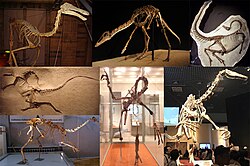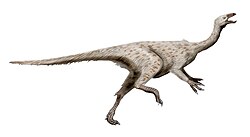
Gallimimus is a genus of theropod dinosaur that lived in what is now Mongolia during the Late Cretaceous period, about seventy million years ago (mya). Several fossils in various stages of growth were discovered by Polish-Mongolian expeditions in the Gobi Desert of Mongolia during the 1960s; a large skeleton discovered in this region was made the holotype specimen of the new genus and species Gallimimus bullatus in 1972. The generic name means "chicken mimic", referring to the similarities between its neck vertebrae and those of the Galliformes. The specific name is derived from bulla, a golden capsule worn by Roman youth, in reference to a bulbous structure at the base of the skull of Gallimimus. At the time it was named, the fossils of Gallimimus represented the most complete and best preserved ornithomimid material yet discovered, and the genus remains one of the best known members of the group.

Alvarezsauridae is a family of small, long-legged dinosaurs. Although originally thought to represent the earliest known flightless birds, they are now thought to be an early diverging branch of maniraptoran theropods. Alvarezsaurids were highly specialized. They had tiny but stout forelimbs, with compact, bird-like hands. Their skeletons suggest that they had massive breast and arm muscles, possibly adapted for digging or tearing. They had long, tube-shaped snouts filled with tiny teeth. They have been interpreted as myrmecophagous, adapted to prey on colonial insects such as termites, with the short arms acting as effective digging instruments to break into nests.

Anserimimus is a genus of ornithomimid theropod dinosaur, from the Late Cretaceous Period of what is now Mongolia. It was a lanky, fast-running animal, possibly an omnivore. From what fossils are known, it probably closely resembled other ornithomimids, except for its more powerful forelimbs.

Struthiomimus, meaning "ostrich-mimic", is a genus of ornithomimid dinosaurs from the late Cretaceous of North America. Ornithomimids were long-legged, bipedal, ostrich-like dinosaurs with toothless beaks. The type species, Struthiomimus altus, is one of the more common, smaller dinosaurs found in Dinosaur Provincial Park; their overall abundance—in addition to their toothless beak—suggests that these animals were mainly herbivorous or omnivorous, rather than purely carnivorous, if at all. Similar to the modern extant ostriches, emus, and rheas, ornithomimid dinosaurs likely lived as opportunistic omnivores, supplementing a largely plant-based diet with a variety of small mammals, reptiles, amphibians, insects, invertebrates, and anything else they could fit into their mouth, as they foraged.
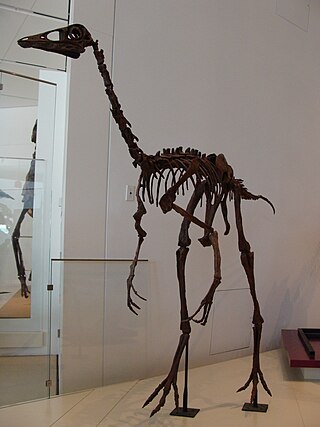
Ornithomimus is a genus of ornithomimid theropod dinosaurs from the Campanian and Maastrichtian ages of Late Cretaceous Western North America. Ornithomimus was a swift, bipedal dinosaur which fossil evidence indicates was covered in feathers and equipped with a small toothless beak that may indicate an omnivorous diet. It is usually classified into two species: the type species, Ornithomimus velox, and a referred species, Ornithomimus edmontonicus. O. velox was named in 1890 by Othniel Charles Marsh on the basis of a foot and partial hand from the Denver Formation of Colorado. Another seventeen species have been named since then, though almost all of them have been subsequently assigned to new genera or shown to be not directly related to Ornithomimus velox. The best material of species still considered part of the genus has been found in Alberta, representing the species O. edmontonicus, known from several skeletons from the Horseshoe Canyon Formation. Additional species and specimens from other formations are sometimes classified as Ornithomimus, such as Ornithomimus samueli from the earlier Dinosaur Park Formation.

Dromiceiomimus is a genus of ornithomimid theropod from the Late Cretaceous of Alberta, Canada. The type species, D. brevitertius, is considered a synonym of Ornithomimus edmontonicus by some authors, while others consider it a distinct and valid taxon. It was a small ornithomimid that weighed about 135 kilograms (298 lb).

Deinocheirus is a genus of large ornithomimosaur that lived during the Late Cretaceous around 70 million years ago. In 1965, a pair of large arms, shoulder girdles, and a few other bones of a new dinosaur were first discovered in the Nemegt Formation of Mongolia. In 1970, this specimen became the holotype of the only species within the genus, Deinocheirus mirificus; the genus name is Greek for "horrible hand". No further remains were discovered for almost fifty years, and its nature remained a mystery. Two more complete specimens were described in 2014, which shed light on many aspects of the animal. Parts of these new specimens had been looted from Mongolia some years before, but were repatriated in 2014.

Avimimus, meaning "bird mimic", is a genus of oviraptorosaurian theropod dinosaur, named for its bird-like characteristics, that lived in the late Cretaceous in what is now Mongolia, around 85 to 70 million years ago.

Garudimimus is a genus of ornithomimosaur that lived in Asia during the Late Cretaceous. The genus is known from a single specimen found in 1981 by a Soviet-Mongolian paleontological expedition in the Bayan Shireh Formation and formally described in the same year by Rinchen Barsbold; the only species is Garudimimus brevipes. Several interpretations about the anatomical traits of Garudimimus were made in posterior examinations of the specimen, but most of them were criticized during its comprehensive redescription in 2005. Extensive undescribed ornithomimosaur remains at the type locality of Garudimimus may represent additional specimens of the genus.

Philip John Currie is a Canadian palaeontologist and museum curator who helped found the Royal Tyrrell Museum of Palaeontology in Drumheller, Alberta and is now a professor at the University of Alberta in Edmonton. In the 1980s, he became the director of the Canada-China Dinosaur Project, the first cooperative palaeontological partnering between China and the West since the Central Asiatic Expeditions in the 1920s, and helped describe some of the first feathered dinosaurs. He is one of the primary editors of the influential Encyclopedia of Dinosaurs, and his areas of expertise include theropods, the origin of birds, and dinosaurian migration patterns and herding behavior. He was one of the models for palaeontologist Alan Grant in the film Jurassic Park.

Archaeornithomimus is a genus of ornithomimosaurian theropod dinosaur that lived in Asia during the Late Cretaceous period, around 96 million years ago in the Iren Dabasu Formation.
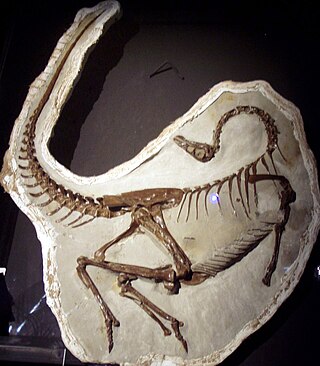
Ornithomimidae is a family of theropod dinosaurs which bore a superficial resemblance to modern ostriches. Ornithomimids were fast, omnivorous or herbivorous dinosaurs known mainly from the Late Cretaceous Period of Laurasia, though they have also been reported from the Lower Cretaceous Wonthaggi Formation of Australia.
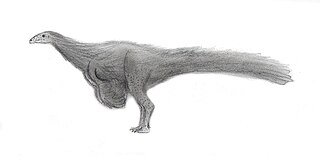
Nqwebasaurus is a basal coelurosaur and is the basal-most member of the coelurosaurian clade Ornithomimosauria from the Early Cretaceous of South Africa. The name Nqwebasaurus is derived from the Xhosa word Nqweba which is the local name for the Kirkwood district, and thwazi is ancient Xhosa for "fast runner". Currently it is the oldest coelurosaur in Africa and shows that basal coelurosaurian dinosaurs inhabited Gondwana 50 million years earlier than previously thought. The type specimen of Nqwebasaurus was discovered by William J. de Klerk who is affiliated with the Albany Museum in Grahamstown. It is the only fossil of its species found to date and was found in the Kirkwood Formation of the Uitenhage Group. Nqwebasaurus has the unofficial nickname "Kirky", due to being found in the Kirkwood.

The Nemegt Formation is a geological formation in the Gobi Desert of Mongolia, dating to the Late Cretaceous. The formation consists of river channel sediments and contains fossils of fish, turtles, crocodilians, and a diverse fauna of dinosaurs, including birds.

Deinocheiridae is a family of ornithomimosaurian dinosaurs, living in Asia and the Americas from the Albian until the Maastrichtian. The family was originally named by Halszka Osmólska and Roniewicz in 1970, including only the type genus Deinocheirus. In a 2014 study by Yuong-Nam Lee and colleagues and published in the journal Nature, it was found that Deinocheiridae was a valid family. Lee et al. found that based on a new phylogenetic analysis including the recently discovered complete skeletons of Deinocheirus, the type genus, as well as Garudimimus and Beishanlong, could be placed as a successive group, with Beishanlong as the most primitive and Deinocheirus as most derived. The family Garudimimidae, named in 1981 by Rinchen Barsbold, is now a junior synonym of Deinocheiridae as the latter family includes the type genus of the former. The group existed from 115 to 69 million years ago, with Beishanlong living from 115 to 100 mya, Garudimimus living from 98 to 83 mya, and Deinocheirus living from 71 to 69 mya. Other genera included are Paraxenisaurus, and possibly Harpymimus and Hexing.

Maniraptoriformes is a clade of dinosaurs with pennaceous feathers and wings that contains ornithomimosaurs and maniraptorans. This group was named by Thomas Holtz, who defined it as "the most recent common ancestor of Ornithomimus and birds, and all descendants of that common ancestor."

This timeline of ornithomimosaur research is a chronological listing of events in the history of paleontology focused on the ornithomimosaurs, a group of bird-like theropods popularly known as the ostrich dinosaurs. Although fragmentary, probable, ornithomimosaur fossils had been described as far back as the 1860s, the first ornithomimosaur to be recognized as belonging to a new family distinct from other theropods was Ornithomimus velox, described by Othniel Charles Marsh in 1890. Thus the ornithomimid ornithomimosaurs were one of the first major Mesozoic theropod groups to be recognized in the fossil record. The description of a second ornithomimosaur genus did not happen until nearly 30 years later, when Henry Fairfield Osborn described Struthiomimus in 1917. Later in the 20th century, significant ornithomimosaur discoveries began occurring in Asia. The first was a bonebed of "Ornithomimus" asiaticus found at Iren Debasu. More Asian discoveries took place even later in the 20th century, including the disembodied arms of Deinocheirus mirificus and the new genus Gallimimus bullatus. The formal naming of the Ornithomimosauria itself was performed by Rinchen Barsbold in 1976.

Aepyornithomimus is a genus of ornithomimid theropod dinosaur from the Late Cretaceous Djadokhta Formation in Mongolia. It lived in the Campanian, around 75 million years ago, when the area is thought to have been a desert. The type and only species is A. tugrikinensis.

Oksoko is a genus of oviraptorid dinosaur from the Late Cretaceous of Asia, that lived in what is now the Nemegt Formation in Mongolia. It includes the type species Oksoko avarsan.
